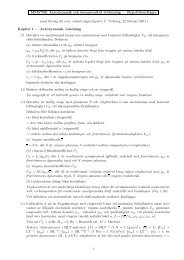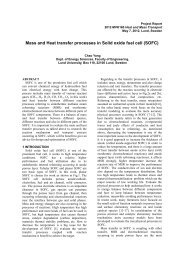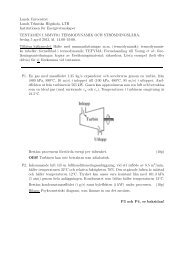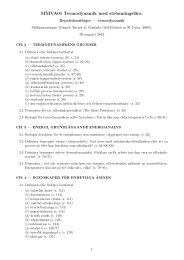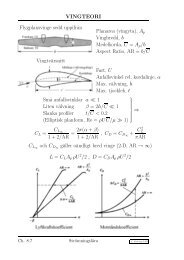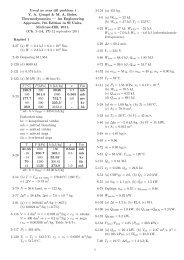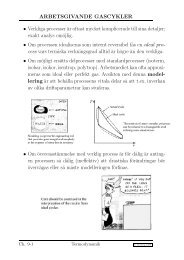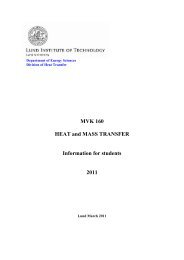heat transfer in liquid film over the surface of a rotating disk ...
heat transfer in liquid film over the surface of a rotating disk ...
heat transfer in liquid film over the surface of a rotating disk ...
Create successful ePaper yourself
Turn your PDF publications into a flip-book with our unique Google optimized e-Paper software.
The <strong>in</strong>terest <strong>in</strong> this subject has <strong>in</strong>creased considerably <strong>over</strong> <strong>the</strong><br />
past few years. Major gas-turb<strong>in</strong>e manufacturers <strong>in</strong> Europe,<br />
U.S.A., and Japan currently fund<strong>in</strong>g a large numbers <strong>of</strong><br />
research projects <strong>in</strong> that direction. In <strong>the</strong> case <strong>of</strong> gas turb<strong>in</strong>e<br />
<strong>disk</strong> cool<strong>in</strong>g, <strong>the</strong> coolant is usually air supplied from <strong>the</strong><br />
compressor section <strong>of</strong> <strong>the</strong> eng<strong>in</strong>e, and its use generally<br />
penalizes <strong>the</strong> eng<strong>in</strong>e cycle performance. Thus <strong>the</strong> objective <strong>of</strong><br />
<strong>disk</strong> cool<strong>in</strong>g scheme design is to provide <strong>the</strong> m<strong>in</strong>imum<br />
necessary coolant consistent with desired eng<strong>in</strong>e life and<br />
reliability. The air supplied to turb<strong>in</strong>e <strong>disk</strong> cool<strong>in</strong>g jets is<br />
usually viewed as hav<strong>in</strong>g two functions. First, it is expected<br />
that <strong>the</strong> high <strong>heat</strong> <strong>transfer</strong> rates normally associated with<br />
imp<strong>in</strong>gement on to stationary <strong>surface</strong>s will be present even<br />
when <strong>the</strong> <strong>surface</strong> is rotat<strong>in</strong>g, and that <strong>the</strong>y will probably be<br />
enhanced by <strong>the</strong> rotation and correspond<strong>in</strong>gly <strong>in</strong>creased relative<br />
velocity between jet and <strong>surface</strong>. Second, it is anticipated that if<br />
multiple jets are used and properly placed, <strong>the</strong>y can prevent <strong>the</strong><br />
undesired radial <strong>in</strong>flow <strong>of</strong> hot combustion gases <strong>in</strong>to <strong>the</strong> cavity<br />
between <strong>the</strong> <strong>disk</strong> and adjacent stationary shroud [2]. Also, an<br />
<strong>in</strong>vestigation, supported by <strong>the</strong> National Aeronautics and Space<br />
Adm<strong>in</strong>istration (NASA-U.S.A), was <strong>in</strong>itiated with <strong>the</strong> primary<br />
objective <strong>of</strong> determ<strong>in</strong><strong>in</strong>g <strong>heat</strong> <strong>transfer</strong> behavior for a variety <strong>of</strong><br />
uniformly spaced imp<strong>in</strong>gement array configuration which<br />
model those <strong>of</strong> <strong>in</strong>terest <strong>in</strong> current and contemplated gas turb<strong>in</strong>e<br />
air foil cool<strong>in</strong>g applications [3].<br />
Fur<strong>the</strong>rmore, <strong>in</strong> many gas-<strong>liquid</strong> <strong>heat</strong> exchangers, <strong>heat</strong><br />
<strong>transfer</strong> performance is controlled by <strong>the</strong>rmal resistance on <strong>the</strong><br />
gas side. Two remedies are available to reduce this resistance:<br />
by <strong>in</strong>creas<strong>in</strong>g <strong>heat</strong> <strong>transfer</strong> area through implementation <strong>of</strong> f<strong>in</strong>s,<br />
and by enhanc<strong>in</strong>g <strong>the</strong> <strong>heat</strong> <strong>transfer</strong> coefficient through<br />
<strong>in</strong>creas<strong>in</strong>g <strong>the</strong> flow or generat<strong>in</strong>g secondary flow. Various<br />
means have been applied to produce secondary flows, for<br />
example oscillation <strong>of</strong> <strong>the</strong> bulk flow, vibration or rotation <strong>of</strong> <strong>the</strong><br />
<strong>surface</strong>, <strong>in</strong>troduction <strong>of</strong> acoustic waves <strong>in</strong>to <strong>the</strong> bulk flow, etc.<br />
In vehicular applications, emphasis on compactness and low<br />
weight discourages not only <strong>surface</strong> addition but also flow<br />
<strong>in</strong>crease as <strong>the</strong> latter will result <strong>in</strong> an <strong>in</strong>crease <strong>in</strong> <strong>the</strong> operat<strong>in</strong>g<br />
pressure, thus requir<strong>in</strong>g <strong>the</strong> re<strong>in</strong>forcement <strong>of</strong> tube or duct walls.<br />
Rotation is one way to achieve <strong>heat</strong> <strong>transfer</strong> enhancement<br />
without suffer<strong>in</strong>g power losses <strong>in</strong> <strong>the</strong> ducts or weight and<br />
volume <strong>in</strong>creases [4]. More<strong>over</strong>, <strong>heat</strong> <strong>transfer</strong> analysis for semiclosed<br />
rotat<strong>in</strong>g <strong>disk</strong> with source flow has been found to be<br />
available to cool high speed memory <strong>disk</strong>s <strong>of</strong> electronic<br />
computers or impellers <strong>of</strong> cryogenic pumps [5].<br />
In contrast, imp<strong>in</strong>g<strong>in</strong>g jets have many applications, <strong>in</strong>clud<strong>in</strong>g<br />
<strong>the</strong> <strong>heat</strong><strong>in</strong>g or dry<strong>in</strong>g <strong>of</strong> food, paper, chemicals, and <strong>the</strong> cool<strong>in</strong>g<br />
<strong>of</strong> combustor components. They are also used <strong>in</strong> glass, metal,<br />
and plastic process<strong>in</strong>g [6].<br />
PROBLEM STATEMENT<br />
In recent years, promotion <strong>of</strong> <strong>heat</strong> <strong>transfer</strong> us<strong>in</strong>g a rotat<strong>in</strong>g <strong>disk</strong><br />
system, with and without, imp<strong>in</strong>gement jet is a matter <strong>of</strong> great<br />
practical importance. The system cool<strong>in</strong>g or <strong>heat</strong><strong>in</strong>g by<br />
imp<strong>in</strong>g<strong>in</strong>g jets has become an established technique, s<strong>in</strong>ce<br />
relatively high local coefficients are obta<strong>in</strong>ed compared with<br />
those for non-imp<strong>in</strong>g<strong>in</strong>g flows. This provides designer with a<br />
means for more effective control <strong>of</strong> <strong>the</strong> temperature <strong>of</strong> <strong>the</strong><br />
system be<strong>in</strong>g <strong>heat</strong>ed or cooled.<br />
LITERATURE SURVEY<br />
In (1987) Sparrow et al [7] described experimentally <strong>the</strong><br />
<strong>heat</strong> <strong>transfer</strong> for a circular jet imp<strong>in</strong>gement on a conf<strong>in</strong>ed <strong>disk</strong>.<br />
The experiments have been performed for a s<strong>in</strong>gle circular jet<br />
imp<strong>in</strong>g<strong>in</strong>g perpendicular to conf<strong>in</strong>ed <strong>disk</strong>, with <strong>the</strong> spent air<br />
be<strong>in</strong>g collected <strong>in</strong> an annulus which surrounds <strong>the</strong> jet delivery<br />
tube. This configuration provides precise control <strong>of</strong> <strong>the</strong> <strong>surface</strong><br />
area affected by <strong>the</strong> imp<strong>in</strong>g<strong>in</strong>g jet and also assures complete<br />
collection <strong>of</strong> <strong>the</strong> spent air. Dur<strong>in</strong>g <strong>the</strong> course <strong>of</strong> <strong>the</strong><br />
experiments, parametric variations were made <strong>of</strong> <strong>the</strong><br />
dimensionless separation distance between <strong>the</strong> jet orig<strong>in</strong> and<br />
<strong>the</strong> imp<strong>in</strong>gement <strong>disk</strong>, <strong>the</strong> ratio <strong>of</strong> <strong>disk</strong> diameter to <strong>the</strong> jet<br />
diameter, and <strong>the</strong> Reynolds number. They showed that <strong>the</strong> <strong>heat</strong><br />
<strong>transfer</strong> coefficient at <strong>the</strong> imp<strong>in</strong>gement <strong>surface</strong> <strong>in</strong>creased<br />
substantially with a decrease <strong>in</strong> <strong>the</strong> jet diameter. Fur<strong>the</strong>rmore,<br />
for smaller diameter jet, <strong>the</strong>re was an optimum separation<br />
distance at which a maximum value <strong>of</strong> <strong>the</strong> <strong>heat</strong> <strong>transfer</strong><br />
coefficient was achieved. Also, for a jet <strong>of</strong> larger diameter, <strong>the</strong><br />
<strong>heat</strong> <strong>transfer</strong> coefficient decreased monotonically as <strong>the</strong><br />
separation distance <strong>in</strong>creased.<br />
In (1988) Goldste<strong>in</strong> and Franchett [8] <strong>in</strong>vestigated<br />
experimentally <strong>the</strong> <strong>heat</strong> <strong>transfer</strong> to a jet imp<strong>in</strong>g<strong>in</strong>g at different<br />
oblique angles to a plane <strong>surface</strong>. The angle between <strong>the</strong> jet<br />
axis and <strong>the</strong> <strong>surface</strong> was varied from 90 to 30 degrees. The<br />
experiment was performed for <strong>the</strong> distance <strong>of</strong> jet orifice to <strong>the</strong><br />
plate rang<strong>in</strong>g from four to ten orifice diameters. The results <strong>of</strong><br />
measurements with <strong>the</strong> range <strong>of</strong> jet Reynolds number from<br />
10000 and 30000. Both <strong>the</strong> jet orifice-to-plate spac<strong>in</strong>g and <strong>the</strong><br />
2



